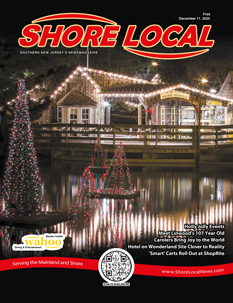By Meteorologist Joe Martucci
“Be a hero, report your zeros.”
That’s the motto Dave Robinson, the New Jersey state climatologist, is telling his over 200 volunteer weather observers across the Garden State. It’s important to report, not just when and where it’s raining, but where it hasn’t rained in this dry spell.
October was the driest month in the state’s history, dating back to 1895 (more on that later in this column). Drought has spread throughout the state.
Robinson helped make that drought determination weekly, in part thanks to the volunteer Community Collaborative Rain Hail and Snow Network (CoCoRaHS), which he oversees.
“It’s very important to know where it hasn’t rained… When the media contacts me, hopefully a couple of weeks from now, it’s not going to be, ‘how’s the drought?’ It’s going to be, ‘Is the drought over?’” Robinson said.
Volunteer efforts go a long way toward telling us when this drought will end. With snow season around the corner, CoCoRaHS also helps meteorologists like me verify forecasts and who saw the most snow.
To be a CoCoRaHS observer, all you need is an open space to put a rain gauge, an internet connection to report observations and an interest in weather. They have an app, too.
Taking observations usually takes less than two minutes a day. When there’s no rain, you just enter zero. When there’s rain, you simply report what’s in the gauge. When snow is coming, you can put a whiteboard in an open space and measure what has fallen.
If you’re on vacation or can’t make it out to the gauge on a given day, no problem. Even if this area is your second home, that’s fine, too. You can input a multi-day entry when you’re back. All they ask is that observations are taken at the same time each day.
There’s a $35 charge to cover the cost of the high-capacity, 4-inch-wide rain gauge, but other than that, it’s free.
There are official training webinars and animations for you to watch and read. I may be biased as a meteorologist, but the training is pretty straightforward, and short. You’ll learn and understand the process quickly.
You can view your reports as well as your neighbors’ anytime on the CoCoRaHS website. A fresh update to their map pages now makes it interactive. You can select dates, map locations and more with a scroll or a few clicks.
Despite the population of Atlantic and Cape May counties being ranked 15 and 20 out of New Jersey’s 21 counties, according to the United States Census Bureau, the density of CoCoRaHS observers is near the top.
There are 29 active observers in Atlantic County and 23 in Cape May County, according to CoCoRaHS data on Nov. 1. Still, more are always welcome. Northfield, Pleasantville, Longport, Margate and Atlantic City are a few towns where there are no regular observers.
CoCoRaHS was founded in Colorado in 1998 by Nolan Doesken. The previous year, Fort Collins, Col., experienced a major flood. Since rainfall observations are generally only taken at airports and a few other sites inbetween, Doesken needed a more localized view of rainfall totals. He asked for measurements from private citizens and CoCoRaHS was born. CoCoRaHS expanded to New Jersey in February 2008 and is now in Canada as well as the Bahamas.
Your observations can make the record books, literally. In 2011, New Jersey’s official record for most annual precipitation was from a volunteer CoCoRaHS observer.
So, if you’re looking for a cheap hobby where you don’t have to leave your property, CoCoRaHS can be the one. Visit www.cocorahs.org if you’re interested in signing up. You can also reach out to me if you need my help.
The driest month on record
Since the Office of the New Jersey State Climatologist started compiling statewide weather records in 1895, there have been over 1,500 months. None have been as dry as October 2024. Last month holds the all-time record for the driest month in recorded history, Robinson told me in our Monthly Weather Roundup, which you can watch at the beginning of each month on my YouTube channel www.youtube.com/joemartwx.
Robinson said that the statewide average was either 0.01 inches or 0.02 inches (unknown as to which at the time of writing). It doesn’t matter.
The previous record was 0.25 inches in 1963, also in October. We crushed the record. That’s less than the average precipitation in Death Valley National Park or Palm Springs in California.
Woodbine, Cape May County, tied for the most rain in the state in October. There, they picked up 0.10 inches. That means drought expanded over the whole state. For the first time since 2012, all of New Jersey was classified in drought by the United States Drought Monitor as of Oct. 31.
Stages of drought include:
D0 Abnormally Dry
D1 Moderate Drought
D2 Severe Drought
D3 Extreme Drought
D4 Exceptional Drought
Severe drought (D2), the second of four stages of drought, is now the case for Atlantic and Cape May counties. It’s New Jersey’s widest extent of severe drought since 2002. From March 2002 to January 2003, mandatory water restrictions went into effect.
There is one small piece of “good” news. If there were ever a good time for no precipitation and drought, it’s mid to late-fall. Water use is way down and nor’easter season is coming. We have until March and April, when the growing season begins, to correct this.
Robinson noted in our weather roundup that any mandatory water restrictions will be weeks away, if it happens.
It’s possible that the state keeps just the voluntary restrictions in effect through the winter and waits to see how much precipitation we receive.
Either way in terms of weather, this is a historic moment period in New Jersey.
Joe earned his Meteorology Degree from Rutgers University. He is approved by the American Meteorological Society as a Certified Broadcast Meteorologist and Certified Digital Meteorologist, the only one in the state with both. He’s won 10 New Jersey Press Association Awards. You can find him on social media @joemartwx












